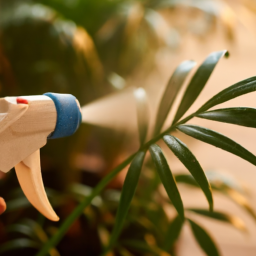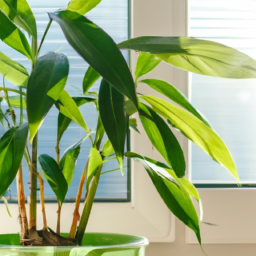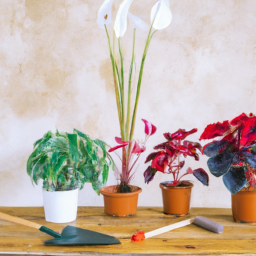
Have you noticed your indoor plants looking a little droopy or lackluster as the seasons change? It may be time to make some sunlight adjustments to ensure they thrive year-round. Adapting indoor plant care for changing seasons is essential for maintaining healthy and happy plants in your home. As the amount and intensity of sunlight shifts throughout the year, it’s important to cater to your plants’ specific needs to help them flourish. In this blog post, we’ll explore the best practices for adjusting sunlight exposure for your indoor plants and provide tips for keeping them thriving no matter the season. So, let’s dive in and learn how to give your plants the light they need to thrive!
Understanding the Importance of Sunlight Adjustments for Indoor Plants
As a plant enthusiast, you know that sunlight is crucial for the growth and well-being of your indoor plants. However, as the seasons change, the amount and intensity of sunlight that your plants receive can vary. It is important to understand how to adjust your plant care routine to ensure that your plants continue to thrive throughout the year.
The Role of Sunlight in Plant Growth
Sunlight is essential for photosynthesis, the process by which plants convert light energy into chemical energy to fuel their growth. Different plants have varying light requirements, with some needing full sun exposure while others thrive in low light conditions. Understanding the specific light needs of your indoor plants is key to providing them with the right amount of sunlight for optimal growth.
During the summer months, plants may receive more direct sunlight due to longer days and higher sun angles. This can lead to an increase in temperature and light intensity, which may cause some plants to become sunburned or dried out. On the other hand, during the winter months, plants may receive less sunlight due to shorter days and lower sun angles. This can result in slower growth and reduced flowering in some plants.
By making adjustments to the amount and intensity of sunlight that your indoor plants receive, you can help them thrive throughout the changing seasons. This may involve moving plants to different locations in your home, using artificial grow lights, or providing shade during the hottest part of the day.
Adapting Indoor Plant Care for Changing Seasons
One way to ensure that your indoor plants receive the right amount of sunlight is to monitor their growth and appearance regularly. If you notice that a plant is becoming leggy or pale, it may be an indication that it is not receiving enough light. On the other hand, if a plant’s leaves are turning yellow or brown, it may be getting too much direct sunlight.
During the summer months, you may need to move plants away from windows or use curtains to filter out excess sunlight. You can also rotate plants regularly to ensure that all sides receive equal light exposure. In the winter, you may need to move plants closer to windows or use artificial grow lights to supplement natural sunlight.
It is also important to consider the specific light requirements of each plant species when making adjustments. Some plants, such as succulents and cacti, thrive in bright, direct sunlight, while others, like ferns and peace lilies, prefer indirect, filtered light. By understanding the individual needs of your plants, you can provide them with the best possible growing conditions.
Tips for Successful Sunlight Adjustments
Here are some tips for successfully adapting your indoor plant care routine for changing seasons:
- Monitor your plants regularly to ensure they are receiving the right amount of sunlight.
- Rotate plants to promote even growth and prevent legginess.
- Use curtains or blinds to filter out excess sunlight during the summer months.
- Consider using artificial grow lights to supplement natural sunlight in the winter.
- Research the specific light requirements of each plant species in your collection.
By following these tips and making adjustments to your plant care routine as needed, you can help your indoor plants thrive throughout the changing seasons. Remember, sunlight is essential for plant growth, so it is important to provide your plants with the right amount of light to ensure their health and vitality.

Tips for Adapting Indoor Plant Care to Changing Seasons
Understanding the Impact of Changing Seasons on Indoor Plants
As the seasons change, so do the light and temperature conditions in our homes. This can have a significant impact on the health and growth of indoor plants. Understanding how these changes affect your plants is the first step in adapting your care routine to ensure they thrive year-round.
During the winter months, the days are shorter and the sun sits lower in the sky, resulting in less natural light reaching your indoor plants. This can lead to slower growth and even dormancy in some species. On the other hand, during the summer months, longer days and more intense sunlight can cause plants to dry out more quickly and require more frequent watering.
Temperature fluctuations can also affect indoor plants, with colder temperatures slowing down growth and warmer temperatures potentially leading to heat stress. It’s important to be mindful of these changes and adjust your care routine accordingly to keep your plants healthy and happy.
In addition to light and temperature, changing seasons can also impact humidity levels in your home. Winter heating can dry out the air, while summer humidity levels may rise. Some plants are more sensitive to these fluctuations than others, so it’s important to monitor humidity levels and make adjustments as needed.
Adapting Light Conditions for Indoor Plants
One of the key factors in adapting indoor plant care to changing seasons is adjusting the amount of light your plants receive. During the winter months, when natural light is limited, consider moving your plants closer to windows or investing in grow lights to supplement their light intake.
In the summer, when the sun is stronger and days are longer, be mindful of placing your plants in direct sunlight for extended periods of time. This can lead to sunburn and heat stress, especially for more delicate species. Instead, opt for bright, indirect light to keep your plants happy and healthy.
It’s also important to rotate your plants regularly to ensure they receive even light exposure on all sides. This can help prevent leggy growth and encourage more balanced development. Pay attention to how your plants respond to different light conditions and make adjustments as needed to optimize their growth.
Adjusting Watering and Temperature for Indoor Plants
In addition to light, watering and temperature are key factors in adapting indoor plant care to changing seasons. During the winter, when temperatures drop and indoor heating is in full swing, plants may require less frequent watering. Be sure to check the soil moisture levels before watering and adjust your schedule accordingly.
In the summer, when temperatures rise and humidity levels fluctuate, plants may need more frequent watering to stay hydrated. Keep an eye on the soil moisture levels and be mindful of any signs of heat stress, such as wilting or yellowing leaves. Consider misting your plants or placing a humidity tray nearby to help maintain optimal moisture levels.
Temperature fluctuations can also impact indoor plants, so be mindful of drafts, air conditioning, and heating vents that may affect their growth. Try to keep your plants in a stable environment with consistent temperatures to minimize stress and promote healthy growth year-round.
By understanding how changing seasons affect your indoor plants and making adjustments to their care routine, you can ensure they thrive no matter the time of year. With a little bit of attention and care, your indoor jungle will continue to flourish and bring joy to your home.

How to Monitor and Adjust Sunlight Levels for Healthy Indoor Plants
Understanding the Importance of Sunlight for Indoor Plants
Before we dive into how to monitor and adjust sunlight levels for your indoor plants, it’s important to understand why sunlight is crucial for their health. Sunlight is essential for photosynthesis, the process by which plants convert light into energy to grow and thrive. Without adequate sunlight, indoor plants can become weak, leggy, and prone to disease.
Indoor plants rely on sunlight to regulate their growth cycles, produce flowers, and maintain vibrant foliage. Different plants have varying sunlight requirements, so it’s important to know the specific needs of your indoor plants to ensure they receive the right amount of light.
Monitoring and adjusting sunlight levels for your indoor plants is key to keeping them healthy and thriving throughout the changing seasons. By understanding how to effectively manage sunlight exposure, you can create an optimal environment for your plants to flourish.
Assessing Sunlight Levels in Your Home
Before making any adjustments to the sunlight exposure for your indoor plants, it’s essential to assess the current sunlight levels in your home. Take note of the direction your windows face and how much natural light filters into each room throughout the day.
South-facing windows typically receive the most sunlight, while north-facing windows receive the least. East-facing windows tend to get morning sunlight, while west-facing windows get afternoon sunlight. Understanding the orientation of your windows will help you determine which areas of your home receive the most sunlight.
It’s also important to consider any obstructions that may block sunlight, such as tall buildings or trees outside your windows. These obstructions can affect the amount of sunlight that reaches your indoor plants, so be mindful of their impact on your plant’s light exposure.
Adjusting Sunlight Levels for Healthy Growth
Once you’ve assessed the sunlight levels in your home, you can begin adjusting the light exposure for your indoor plants. If your plants are not receiving enough sunlight, consider moving them to a sunnier spot or investing in grow lights to supplement natural light.
On the other hand, if your plants are getting too much sunlight and are showing signs of sunburn or wilting, you may need to move them to a shadier location or use sheer curtains to filter the light. It’s essential to strike a balance between too little and too much sunlight to ensure your plants thrive.
Regularly monitor your indoor plants for any changes in their growth or appearance, as this can indicate whether they are receiving the right amount of sunlight. Adjusting sunlight levels as needed will help your plants adapt to the changing seasons and stay healthy year-round.
In a Nutshell
As the seasons change, so do the needs of our indoor plants. With the amount of sunlight varying throughout the year, it’s important to make adjustments to ensure our plants continue to thrive. During the summer months, plants may need more sunlight to support their growth and blooming. Placing them near a window that receives ample sunlight or even moving them outside for a few hours can help provide the necessary light they need.
In contrast, during the winter months, the amount of sunlight decreases, which can impact the growth of our plants. To adapt, consider moving your plants closer to a window or investing in grow lights to supplement their light needs. Additionally, rotating your plants regularly can help ensure they receive even exposure to sunlight on all sides. By making these simple adjustments based on the changing seasons, you can help your indoor plants thrive year-round.
FAQ Roundup:
Q1: Why is it important to adjust indoor plant care for changing seasons?
A1: It is important to adjust indoor plant care for changing seasons because the amount of sunlight and temperature changes throughout the year, affecting the growth and health of your plants.
Q2: How can I adapt my indoor plant care routine for less sunlight in the winter?
A2: To adapt to less sunlight in the winter, you can move your plants closer to windows, use grow lights, or rotate your plants to ensure they are getting enough light.
Q3: What should I do to care for my indoor plants during the summer months with more sunlight?
A3: During the summer months with more sunlight, make sure to water your plants more frequently, provide shade if needed, and monitor for signs of sunburn or heat stress.
Q4: How can I help my indoor plants transition between seasons smoothly?
A4: To help your indoor plants transition between seasons smoothly, gradually adjust their light exposure and watering schedule, and keep an eye out for any signs of stress or nutrient deficiencies.
Q5: Are there any specific indoor plants that are better suited for changing seasons?
A5: Some indoor plants are more adaptable to changing seasons, such as pothos, spider plants, and peace lilies. These plants are more resilient and can thrive in different light and temperature conditions.

James Wong is a renowned ethnobotanist, plant scientist, and local television presenter. With a passion for demystifying plant science, he is known for translating complex botanical concepts into practical advice for everyday plant enthusiasts. James’s expertise spans from traditional gardening to cutting-edge plant technologies, making his insights accessible and informative.


